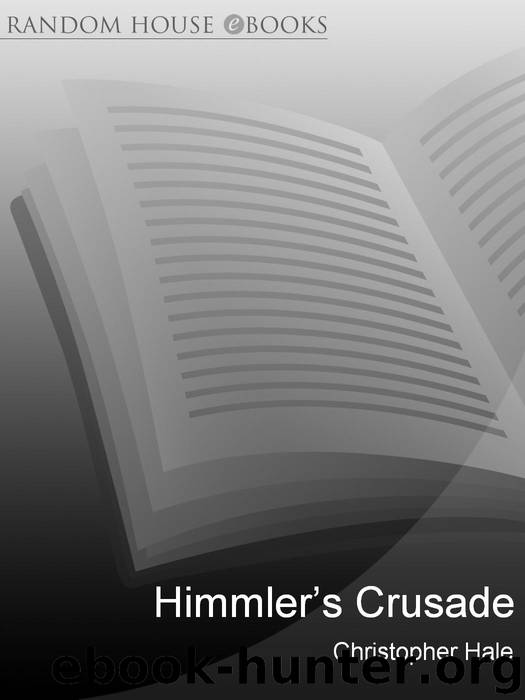Himmler's Crusade by Christopher Hale

Author:Christopher Hale
Language: eng
Format: epub
Publisher: Transworld
Published: 2009-04-12T16:00:00+00:00
Chapter Ten
WEIRD BARBARITY
‘The veil has been torn aside and the naked city [of Lhasa] has been revealed in all its weird barbarity.’
– Colonel Sir Thomas H. Holdich, 1906
‘In particular we must guard ourselves against the barbaric red communists, who carry terror and destruction with them wherever they go . . .’
– Testament of the 13th Dalai Lama
Ernst Schäfer had entered a strange and perplexing world. Tibetans frequently complain that Westerners have turned Tibet into a spiritual Disneyland. Donald Lopez, an American scholar of Buddhism, has called Tibetans ‘Prisoners of Shangri-la’. His reference is, of course, to the famous book by James Hilton published in 1933, soon turned into a Hollywood smash hit. Hilton represented Tibet as a kind of theosophical retreat which provided just about every spiritual solace except colonic irrigation. But his fiction simply gave a name to a long tradition. Scholars, travellers, diplomats as well as a lunatic fringe have for centuries pictured Tibet as a spiritual fastness, isolated, unchanging and pure. It was never anything of the sort, and it certainly wasn’t in 1939. The story of that restless, bitter decade in Lhasa begins at the end of 1933.
On 12 December that year, Thubten Gyatso, the ‘Great’ 13th Dalai Lama, was reported to be feeling unwell.1 His monks were informed that he could no longer appear for public audiences and instead he would be represented by a ceremonial robe placed on his throne. This was known as a ‘throne audience’, or ‘inviting the clothes’. Many monks found his absence very distressing and became fearful about the condition of Tibet’s spiritual ruler. They were right to be concerned. Inside the Dalai Lama’s Norbulinka Palace there was intense and highly secretive fear. Tibet’s theocratic ruler had been ill for twelve days, complaining of a poor appetite, shortness of breath and difficulty walking more than a few steps. When it became widely rumoured that the Dalai Lama had still not recovered some days later, monks in the monasteries that encircle Lhasa began continuously to chant ‘The Prayer of Long Life’ night and day, stopping only to relieve themselves. On the 16th, the Dalai Lama’s favourite, Kumbela (Dechen Chödrön), entered the Dalai Lama’s quarters and discovered his master panting for breath. He immediately summoned the State Oracle from Nechung.
Other important lamas now came running to the palace to urge the Dalai Lama to ‘remain in his body’ – that is to say, not to pass on to another incarnation. The Nechung Oracle also made a more practical recommendation: the Dalai Lama must take a medicine called ‘the seventeen heroes for subduing colds’. For reasons that will never be known, the Dalai Lama refused. The Oracle insisted and poured a dose of ‘seventeen heroes’ down the Dalai Lama’s throat himself. The condition of the patient immediately worsened and he lapsed into unconsciousness. The Great 13th, the spiritual ruler of Tibet, never spoke again and died on 17 December at 6.30 p.m. On the roof of the Potala Palace butter lamps were lit to signify that a death had taken place and the dama drums began tolling.
Download
This site does not store any files on its server. We only index and link to content provided by other sites. Please contact the content providers to delete copyright contents if any and email us, we'll remove relevant links or contents immediately.
| Belgium | France |
| Germany | Great Britain |
| Greenland | Italy |
| Netherlands | Romania |
| Scandinavia |
Room 212 by Kate Stewart(4116)
The Crown by Robert Lacey(4115)
Endurance: Shackleton's Incredible Voyage by Alfred Lansing(3856)
The Iron Duke by The Iron Duke(3651)
The Rape of Nanking by Iris Chang(3526)
Killing England by Bill O'Reilly(3461)
Joan of Arc by Mary Gordon(3271)
Say Nothing by Patrick Radden Keefe(3069)
I'll Give You the Sun by Jandy Nelson(2847)
Hitler's Monsters by Eric Kurlander(2737)
Shadow of Night by Deborah Harkness(2731)
Margaret Thatcher: The Autobiography by Thatcher Margaret(2689)
Mary, Queen of Scots, and the Murder of Lord Darnley by Alison Weir(2682)
Darkest Hour by Anthony McCarten(2651)
Blood and Sand by Alex Von Tunzelmann(2611)
Red Famine: Stalin's War on Ukraine by Anne Applebaum(2470)
Eleanor & Park by Rainbow Rowell(2399)
The One Memory of Flora Banks by Emily Barr(2351)
Book of Life by Deborah Harkness(2274)
